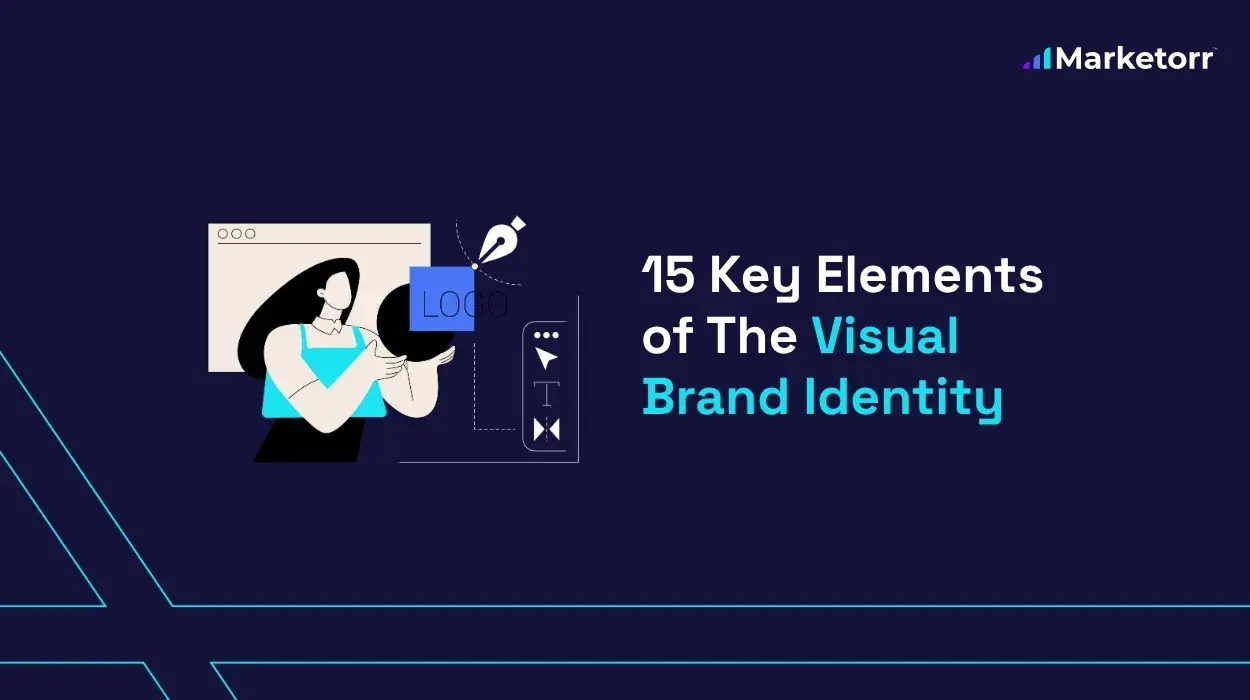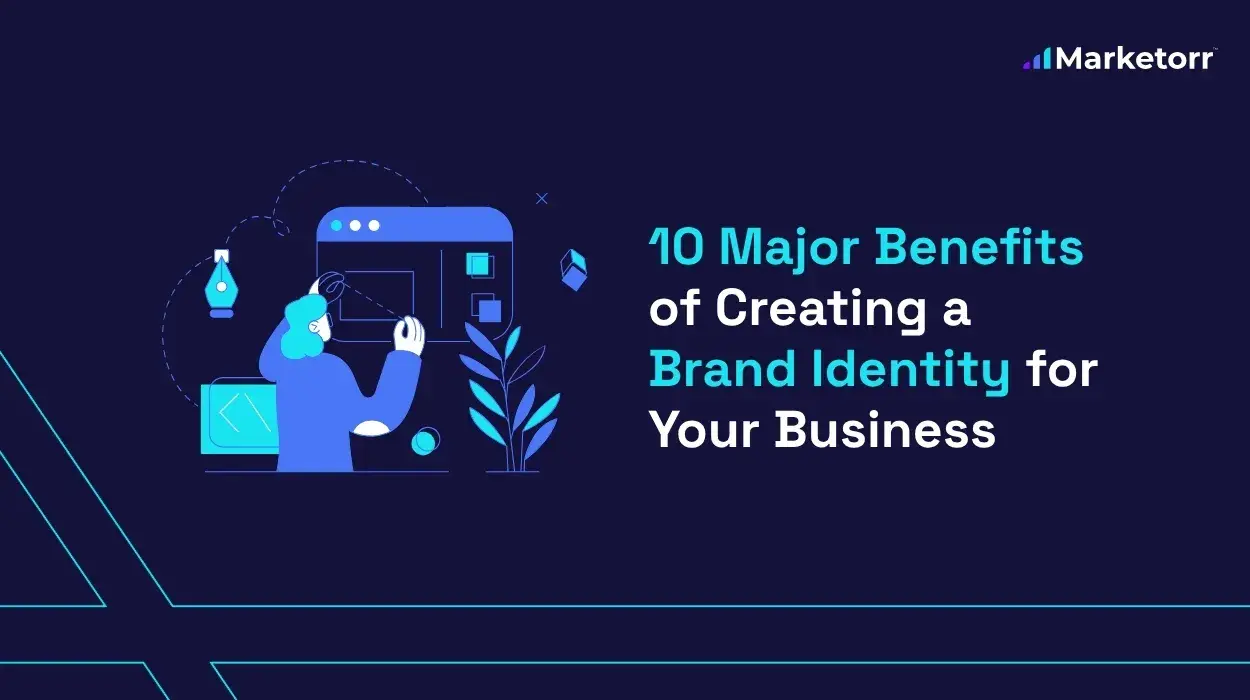Backlinks remain one of Google’s strongest ranking signals, even after numerous algorithm updates. A 2024 Ahrefs study revealed that 91% of web pages get no search traffic, largely due to a lack of backlinks.
Google’s systems still rely heavily on link signals to evaluate domain authority, content trust, and relevance. Strong backlinks improve visibility, indexing speed, and referral traffic, while low-quality ones risk penalties.
As search engines become more context-aware, backlink quality, placement, and source relevance have become more critical than ever. Understanding how backlinks shape rankings is essential for sustainable SEO performance.
In this guide, we’ll break down why backlinks matter, what makes them valuable, the different types you should know, and how to build them the right way. Every section is backed by updated examples and plain advice for anyone working on real SEO results.
Why Do Backlinks Matter for Search Engine Rankings?
Backlinks act like trust signals for search engines. When one site links to another, it’s a vote that says, “this content is worth checking out.”
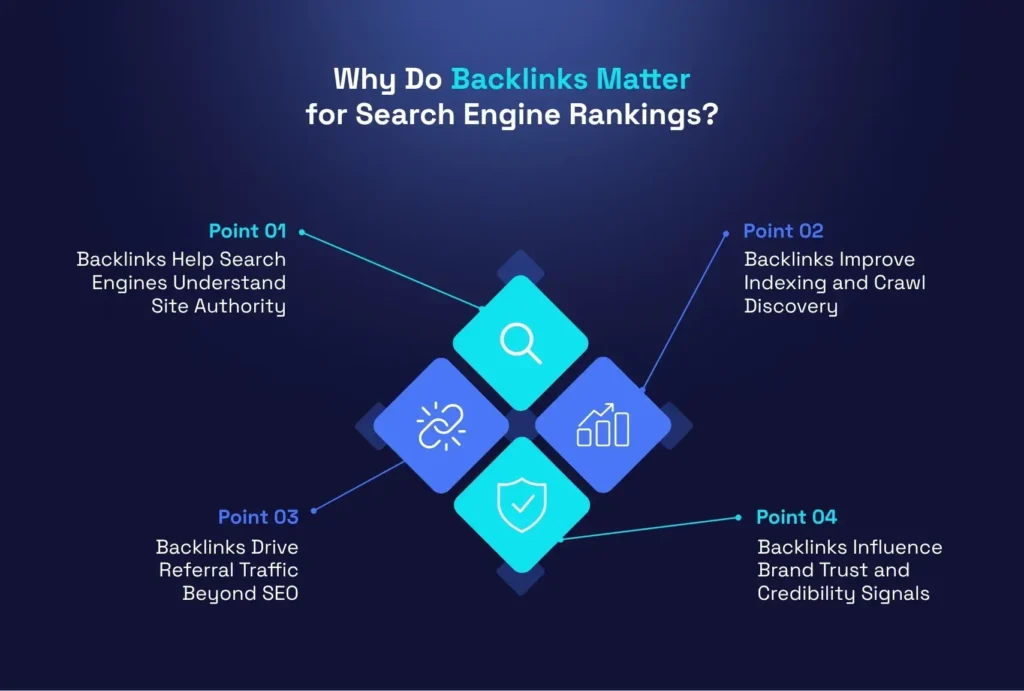
1. Backlinks Help Search Engines Understand Site Authority
Search engines use backlinks to figure out which sites have more authority in a given niche.
If other trusted websites link to your pages, Google sees your site as more valuable and pushes it up in rankings. This is especially true if the links come from websites that are already well-established.
For example, if a respected industry blog or .edu site links to your article, that single link can do more for your rankings than dozens of weak or irrelevant links.
2. Backlinks Improve Indexing and Crawl Discovery
Search engines discover new content by crawling links from one page to another.
If your website gets a link from a page that’s already in Google’s index, it helps your new page get found faster. This is useful when you launch a new site or publish fresh content you want indexed quickly.
Websites with no backlinks often get ignored for weeks, or never crawled at all.
3. Backlinks Drive Referral Traffic Beyond SEO
Some people click on links directly, which sends referral traffic to your site.
This traffic can be just as valuable as search traffic. If someone reads a blog post and clicks through to your product or service, they’re already somewhat interested. That means better engagement and possibly more conversions.
Backlinks from relevant sources also mean that visitors come in already trusting your brand.
4. Backlinks Influence Brand Trust and Credibility Signals
Getting links from reputable sites makes your brand look more trustworthy, both to users and to Google.
For instance, if you’re featured in an industry magazine or on a government (.gov) or academic (.edu) site, that link signals you’re a credible player. This matters even more if you’re in finance, health, or any YMYL (Your Money Your Life) niche where trust is essential.
Over time, strong backlinks help build brand recognition and reinforce your authority.
What Makes a High-Quality Backlink?
Not all links help your rankings. Some are ignored, and others can actually damage your site.
A high-quality backlink is one that adds real value and fits naturally within the content of a trusted, relevant website.
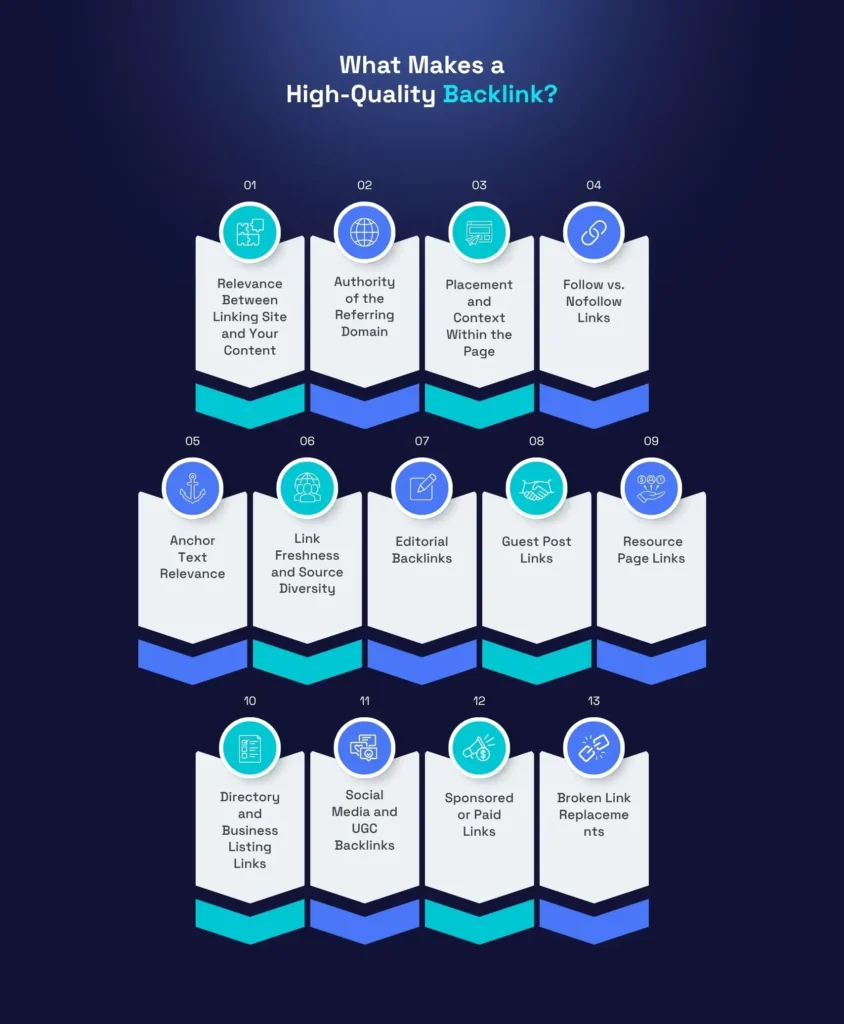
1. Relevance Between Linking Site and Your Content
Google looks at how closely related the linking site is to your content.
For example, if your page is about digital marketing and it gets linked from a photography blog, it might not make much sense. But if the link comes from a site that talks about SEO or online business, it’s far more valuable.
Topical relevance helps Google understand the niche you’re in.
2. Authority of the Referring Domain
Links from strong websites carry more weight than links from low-quality ones.
Sites like Forbes, TechCrunch, or government portals have high domain authority. Getting backlinks from those types of sources tells Google that your content meets a higher standard.
On the other hand, links from spammy blogs, low-effort directories, or PBNs (private blog networks) are either ignored or penalized.
3. Placement and Context Within the Page
Where the link appears matters.
Links placed naturally inside the main content, especially near the top of a page, are stronger than links buried in footers or sidebars. Google wants to see that someone linked to you in a way that makes sense for the reader.
A good link should feel like part of the article, not something that was added just to pass SEO value.
4. Follow vs. Nofollow Links
A “follow” link tells search engines to count the link as a ranking signal.
A “nofollow” link tells them not to follow or pass authority. That said, Google now treats nofollow as a “hint,” meaning it might still consider it if the link comes from a quality site.
It’s good to have a mix of both. Most natural backlink profiles do.
5. Anchor Text Relevance
Anchor text is the visible, clickable part of the link.
Google pays close attention to this. If the text clearly describes the page it’s pointing to, the link is stronger. For example, a link with the anchor “best SEO tools” going to an SEO tools review page makes perfect sense.
Over-optimizing anchor text with exact keywords, though, can backfire. Natural, varied anchors work better.
6. Link Freshness and Source Diversity
Google likes to see that your site continues earning links over time, not just in one short burst.
If all your backlinks come from a single site, or they all show up in the same week, that’s a red flag. A healthy link profile has a mix of sources, and new links keep your site relevant.
Old links are still useful, but recent ones show Google that your content is still being talked about.
Different Types of SEO Backlinks Explained
There are several types of backlinks, and each has its own value depending on how it’s earned and where it comes from. Understanding the differences helps you focus on building links that actually move your rankings, instead of wasting time on low-value sources.
7. Editorial Backlinks
Editorial backlinks happen naturally when someone links to your content because they found it useful.
This usually comes from blog posts, news articles, or resources where your site is mentioned as a reference. For example, if a digital marketing blog links to your case study on backlink strategies, that’s an editorial link.
These links are highly trusted by search engines because they show that your content adds value without you asking for it.
8. Guest Post Links
Guest blogging is still a solid way to earn backlinks if it’s done the right way.
When you contribute an article to a relevant site and include a link back to your own, you’re building authority and exposure. But it only works if the site is reputable and the content fits naturally with their audience.
Sites that allow anyone to post without reviewing content don’t hold much value anymore. Google now checks the quality of both the site and the post itself.
9. Resource Page Links
Some websites keep curated lists of useful links, which are called resource pages. If your content fits well into a guide or tool roundup, it might be added as a helpful reference.
For example, a university page about online education might link to your blog if it offers a strong guide on learning SEO.
These links are great because they often stay live for a long time and can send steady referral traffic.
10. Directory and Business Listing Links
Online directories are still relevant if they’re high quality and niche-specific.
Getting listed on a trusted business directory like Clutch, Crunchbase, or local chambers of commerce can help boost local SEO and brand visibility. But links from spammy directories or link farms no longer help, and may hurt your site.
Focus on platforms that provide real visibility, not just backlinks.
11. Social Media and UGC Backlinks
User-generated content (UGC) includes backlinks from forums, social media profiles, and community platforms like Reddit, Quora, or LinkedIn.
These are mostly nofollow links, but they can still be useful. They bring visibility, engagement, and sometimes help new content get indexed faster. If your link gets shared widely or mentioned in comments under popular posts, it can even lead to editorial links later.
These backlinks support brand awareness and indirect SEO value.
12. Sponsored or Paid Links
Paid links are any backlinks you pay for, directly or indirectly.
Google’s guidelines require these to be marked as “sponsored,” otherwise they can be seen as manipulation. That doesn’t mean they’re useless. When disclosed properly, they still help with branding, exposure, and sometimes rankings, especially in affiliate-heavy industries.
But relying on paid links too much is risky and not sustainable.
13. Broken Link Replacements
This method involves finding broken links on other sites and suggesting your own content as a replacement.
It works well if you have a relevant article that fills the gap. Tools like Ahrefs and Semrush make it easier to identify dead links on high-authority pages.
This strategy helps both sides, you get a backlink, and the other site improves its content quality.
Backlink Strategies That Still Work in 2025
Even as Google’s algorithm gets smarter, earning backlinks the right way is still one of the most effective SEO tactics. The difference now is that shortcuts no longer work. Sustainable link building in 2025 relies on real value, relevance, and content that deserves to be linked.
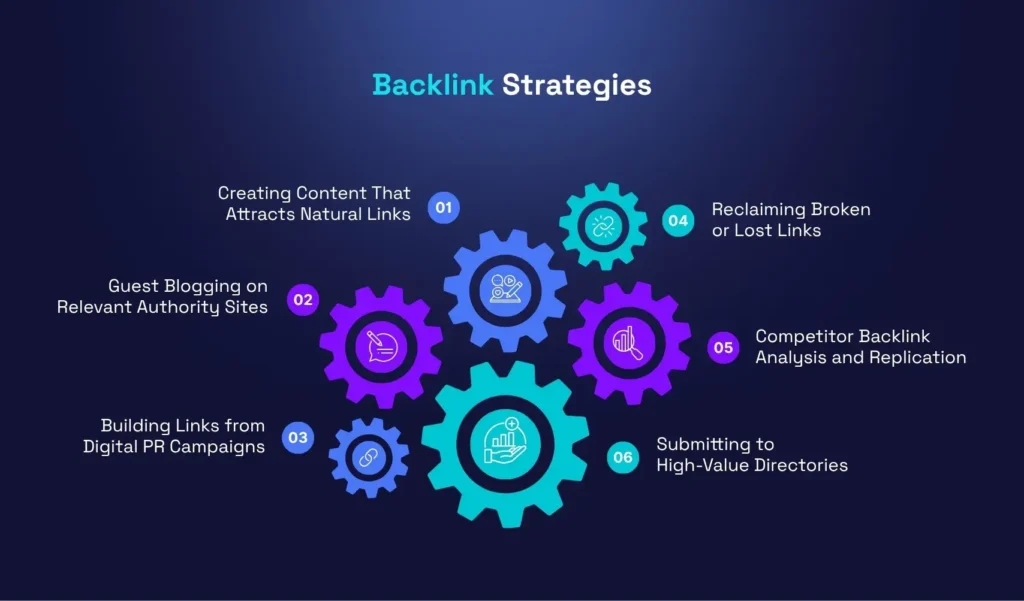
Creating Content That Attracts Natural Links
Backlinks often come when your content actually deserves attention.
Pages that include unique statistics, deep research, visual storytelling, or practical solutions tend to attract links naturally over time. These links aren’t asked for, they’re earned because someone found the content useful enough to cite or share.
For example, a detailed guide on B2B SEO with data from your own case studies is more likely to be referenced by other marketers or blogs. If it’s well-presented, even journalists may pick it up. Visual content like infographics and original charts also increases linkability, especially when republished by bloggers or trade publications.
Long-term, this is the most stable way to build backlinks without constant outreach.
Guest Blogging on Relevant Authority Sites
Guest blogging is still effective, but only when it’s done for the right reasons.
You need to target websites that have a strong reader base and real editorial standards. Writing insightful, helpful content for them positions you as an expert and earns a backlink in return.
This works best in niches like SaaS, finance, health, and education where people still value expert-written articles.
Low-quality guest posts stuffed with keyword anchors on random sites won’t help anymore. Google’s recent updates specifically target these kinds of patterns.
The goal isn’t just the link, it’s to contribute something meaningful to an existing audience.
Building Links from Digital PR Campaigns
Digital PR combines SEO with brand exposure. It’s link building at scale, without looking like link building.
This strategy involves creating newsworthy content like reports, surveys, opinion pieces, or product launches that can be pitched to journalists, bloggers, and media outlets. If the story is strong, it gets picked up and linked organically.
For example, a cybersecurity startup might publish a study on the most common types of phishing attacks by industry, then offer insights to media platforms. These data-driven pieces often earn backlinks from .gov, .edu, and top-tier news sites.
What makes this approach powerful is that the links are hard to replicate because they’re earned, not built.
Reclaiming Broken or Lost Links
Links get lost all the time. Pages are moved, URLs change, and old posts are deleted.
Finding and fixing these lost links can restore SEO value without needing to create anything new.
Tools like Ahrefs, Screaming Frog, and Google Search Console can help you locate backlinks pointing to broken pages. Once found, you can either set up a redirect or ask the referring site to update the link.
This is especially effective if your site has been live for a few years. Older content often picks up links that get broken over time as your site structure evolves.
It’s one of the easiest wins in technical SEO.
Competitor Backlink Analysis and Replication
Your competitors have already done part of the work, you just need to study what they’ve done.
By analyzing their backlink profiles, you can uncover patterns: which blogs link to them, where they’re being featured, what kind of content gets the most links. Once you have that map, it becomes easier to create similar or better content and pitch the same sources.
You might discover that a competitor’s blog post on “eCommerce SEO mistakes” has been linked to from dozens of business blogs. That tells you the topic is worth targeting with your own take, especially if you can add original insights or data.
It’s not about copying, it’s about finding openings they already proved work.
Submitting to High-Value Directories (Not Link Farms)
Directories are only helpful if they’re curated and well-respected.
Being listed on websites like Crunchbase, Clutch, DesignRush, or relevant industry databases still adds SEO value and visibility. These sites often have high domain authority and real user traffic. They’re also commonly used by potential customers, journalists, and analysts.
This helps you rank better and get discovered by people actively searching in your niche.
Avoid mass-submission services or directories where anyone can post without review. Those are outdated and likely to get ignored or worse, flagged by search engines.
How Many Backlinks Do You Really Need to Rank?
There’s no universal answer for how many backlinks you need. It depends on your industry, your competition, and your content quality.
For a low-competition keyword, 5–10 quality links from relevant domains might be enough. For something like “best project management tools,” you could need 200+ referring domains just to break into page one. A 2024 Semrush analysis showed that top-ranking pages for high-volume keywords had, on average, 350–400 unique referring domains.
But that doesn’t mean chasing numbers. A handful of strong backlinks from trusted sources can outperform hundreds of weak ones.
It’s about building authority over time, not trying to force fast results.
Are There Risks with Bad Backlinks?
Yes, bad backlinks can harm your site’s rankings. Not all links are helpful, and some can even trigger penalties from search engines.
Google has gotten much better at detecting manipulative linking patterns. If your site has too many spammy, irrelevant, or clearly paid links without proper disclosure, it could be flagged for violating Google’s link spam policies.
Links from link farms, private blog networks (PBNs), or automated link exchanges are especially risky. These schemes used to work a decade ago, but now they’re considered shortcuts that damage your site’s reputation.
In 2024, Google’s Link Spam Update introduced SpamBrain to further automate link quality detection. If your site gets caught, you might not see a manual penalty, but you’ll notice rankings drop quietly as those links are devalued.
Removing or disavowing bad backlinks is part of ongoing SEO hygiene. It doesn’t fix everything, but it’s a needed step if you’ve inherited poor links or made mistakes in the past.
Even if you’re not actively spamming, buying cheap links or hiring low-quality agencies can still hurt your domain in the long run. It’s better to build slow, strategic links than chase shortcuts.
How Backlinks Fit Into Your Overall SEO Strategy
Backlinks are just one piece of the SEO puzzle but they connect to nearly every other part of your strategy.
Without good content, no one wants to link to your site. Without technical SEO, your pages might not get indexed. And without backlinks, even the best content may never rank on page one.
Think of backlinks as external votes of confidence. On-page content shows Google what your page is about, but backlinks show that others find it useful. This combination is what helps search engines decide which pages deserve to rank higher.
For example, a blog post that explains a topic clearly and also earns links from university sites, blogs, and directories will almost always outrank one that’s equally well-written but has no links.
Backlinks also support your content strategy. If you build content clusters around core topics and each piece earns some links, they strengthen each other and help your entire site rank better.
Over time, strong backlinks contribute to domain authority, which helps new content rank faster, even with fewer links. This is how websites build SEO momentum.
The best strategies align content creation, outreach, and link building in one loop, where each part supports the others.
Need Better Backlinks That Actually Help You Rank?
If your site isn’t ranking the way it should, backlinks might be the missing piece. But not just any links, the right ones from trusted, relevant sources.
At Marketorr, we help websites build links that make sense, not just for search engines, but for real people too. No spam. No shortcuts. Just honest SEO that works.
Send us a message or book a free chat.
Final Thoughts
Backlinks remain essential in 2025, not because they’re trendy, but because they still tell search engines which pages are worth showing to users.
They help establish authority, improve discovery, and drive both rankings and real traffic. But they only work when they’re earned in the right way, through relevance, trust, and quality.
SEO isn’t just about optimizing pages; it’s about creating something others want to reference. And backlinks are the clearest signal that you’ve done exactly that.
For sustainable results, build links steadily, audit your profile regularly, and always put user value at the center of your strategy.




